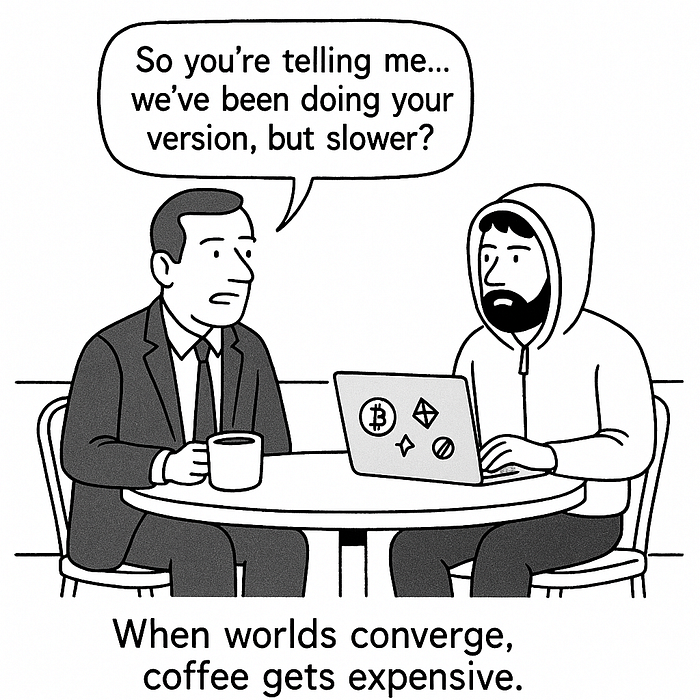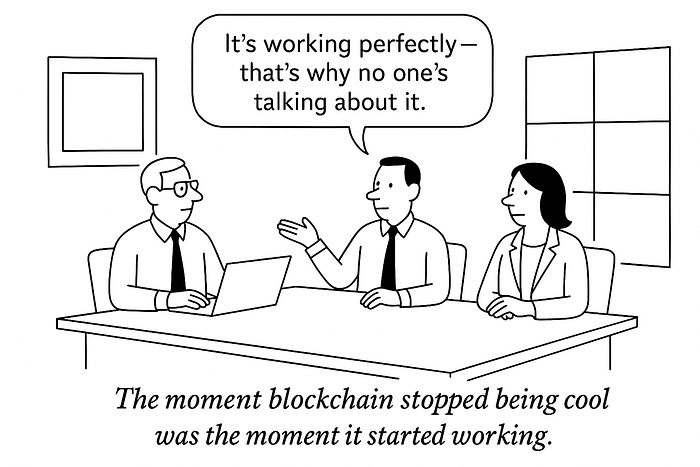The Future of Blockchain
It’s the present. Just… better.
Something I often get asked, or, more truthfully, something I keep asking myself, is what do I think about the future of blockchain?
It’s a fair question, and the industry has been talking about it for over a decade, and yet, depending on who you ask, it’s either the most overhyped idea in tech or the invisible infrastructure quietly eating finance, supply chains, and identity systems from the inside out.
So here are a few thoughts of mine, not predictions, but reflections, on where I think this is heading.
1. Blockchain succeeds when we stop talking about blockchain
That’s not a bad thing. It doesn’t mean it goes away; it means it wins.
When we stopped talking about TCP/IP, it wasn’t because it failed, it was because it became the plumbing of the internet. Blockchain will follow that path.
It’ll live in the background of payments, settlement, compliance, and ownership. People will use it without knowing they’re using it. It’ll be part of the operating system of modern life, transparent where needed, invisible where not.
2. Speculation isn’t going anywhere, it just grows up
We’ve opened Pandora’s box with tokenisation where it’s less meme, and more access.
Tokenisation lets us invest in what was once out of reach: private equity, infrastructure projects, music royalties, real-world receivables, the long tail of “uninvestable” assets (or dark markets as a colleague of mine puts it).
That access creates speculation, yes, but also liquidity and price discovery in places that never had it before.
The trick here will be maturity. What drives token prices in future will start to mirror what drives equities today: revenue, adoption, yield, and brand. That doesn’t kill hype, it just gives it fundamentals to cling to.
3. Success gets harder, but more meaningful
Once upon a time, the (crypto) genie was mostly in the lamp.
Stablecoins, smart contracts, and programmable payments were playgrounds for the cyberpunks and the degens. Now the grown-ups are here: banks, payment giants, governments.
That makes it harder to stand out, but it also makes it real.
Big players bring distribution, but not agility. Innovation still belongs to those who move fast, who test, fail, and iterate in the open.
The next wave of unicorns won’t look like the last. They’ll build quietly, integrate deeply, and power things we use every day without noticing.
Pressure makes diamonds, right? Well right now, this industry is under a lot of pressure.

4. Regulation stops being the enemy
The early ethos was “code is law.” The next era accepts that law meets code.
The most interesting work now happens where those two worlds collide (TradFi and DeFi), programmable compliance, on-chain reporting, tokenised bonds that reconcile in real time.
Builders who embrace that complexity will shape the frameworks others follow. The ones who fight it will fade.
Regulation doesn’t kill innovation; incoherence does. The clearer the rules, the faster capital and talent flow in.
5. The next narrative is boring…and that’s brilliant
“DeFi summer” had vibes. NFTs/ICOs had chaos.
The next era… will look boring… and that’s exactly the point.
It’ll be about infrastructure, security, and composability. About making tokenisation boring enough for accountants to trust and stable enough for superannuation (aka pension) funds to hold.
The headlines will slow down, but the adoption curve won’t.
That’s how revolutions end… quietly, in production.
6. The real future is co-intelligent
AI and blockchain aren’t separate revolutions; they’re halves of the same one.
Blockchain gives us trusted systems; AI gives us adaptive agents. The future is where they meet, human-steered AI agents transacting on transparent, auditable rails.
It’s not decentralisation versus intelligence; it’s decentralised intelligence.
That’s where things get interesting again.
7. Crypto taught us how to build communities… and that lesson sticks
For all its chaos, crypto has been a masterclass in community building.
It taught the world how to rally around a shared vision, how to reward early participation, and how to connect people to a project before it’s finished.
That’s a blueprint every other industry will eventually follow.
The next decade will be more community-driven, not less. We’ll follow founders from idea to execution, own a piece of the journey, and shape outcomes through governance, engagement, and aligned incentives.
The future of innovation isn’t just built… it is co-owned.
8. The pilots shaping tomorrow
If you want to see the future of blockchain, look at the pilots, not the headlines.
Central banks like the Reserve Bank of Australia are already running projects such as Project Acacia, testing tokenised settlement, securitisation, and programmable payments in real regulatory environments.
These are more than just experiments, they’re reference models. Once the heavy lifting is done, they make it easier for everyone else to follow.
People underestimate how hard it is to get these projects off the ground: the governance, the legal reviews, the coordination between institutions
But that’s exactly why they matter.
They prove what’s possible within the rules, and every successful pilot clears the runway for licensed, scalable, real-world adoption.
There’s power in exposure, too. When central banks, major institutions, and regulators go hands-on, it changes perception. The narrative shifts from “if” to “when.”

The future of blockchain isn’t ten years away. It’s being tested in sandboxes, audited in pilots, and written into policy drafts right now.
The irony is we’ll only realise that once we stop calling it “the future.”
Listen To The Article

Black Friday 30%
Offer









